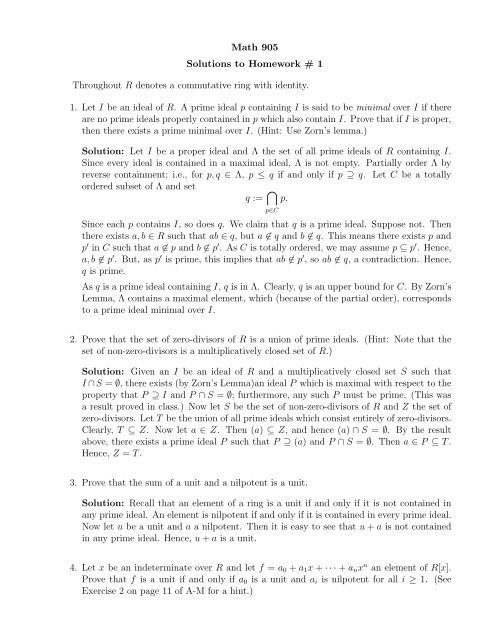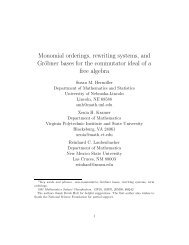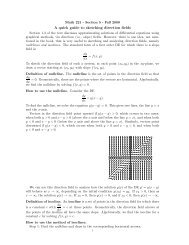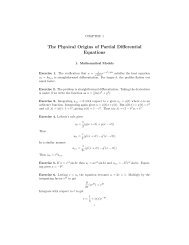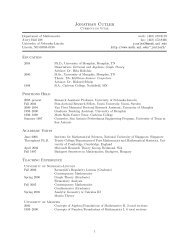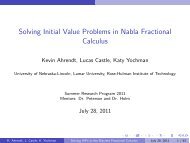Math 905 Solutions to Homework # 1 Throughout R denotes a ...
Math 905 Solutions to Homework # 1 Throughout R denotes a ...
Math 905 Solutions to Homework # 1 Throughout R denotes a ...
Create successful ePaper yourself
Turn your PDF publications into a flip-book with our unique Google optimized e-Paper software.
<strong>Math</strong> <strong>905</strong><br />
<strong>Solutions</strong> <strong>to</strong> <strong>Homework</strong> # 1<br />
<strong>Throughout</strong> R <strong>denotes</strong> a commutative ring with identity.<br />
1. Let I be an ideal of R. A prime ideal p containing I is said <strong>to</strong> be minimal over I if there<br />
are no prime ideals properly contained in p which also contain I. Prove that if I is proper,<br />
then there exists a prime minimal over I. (Hint: Use Zorn’s lemma.)<br />
Solution: Let I be a proper ideal and Λ the set of all prime ideals of R containing I.<br />
Since every ideal is contained in a maximal ideal, Λ is not empty. Partially order Λ by<br />
reverse containment; i.e., for p, q ∈ Λ, p ≤ q if and only if p ⊇ q. Let C be a <strong>to</strong>tally<br />
ordered subset of Λ and set<br />
q := <br />
p.<br />
p∈C<br />
Since each p contains I, so does q. We claim that q is a prime ideal. Suppose not. Then<br />
there exists a, b ∈ R such that ab ∈ q, but a ∈ q and b ∈ q. This means there exists p and<br />
p ′ in C such that a ∈ p and b ∈ p ′ . As C is <strong>to</strong>tally ordered, we may assume p ⊆ p ′ . Hence,<br />
a, b ∈ p ′ . But, as p ′ is prime, this implies that ab ∈ p ′ , so ab ∈ q, a contradiction. Hence,<br />
q is prime.<br />
As q is a prime ideal containing I, q is in Λ. Clearly, q is an upper bound for C. By Zorn’s<br />
Lemma, Λ contains a maximal element, which (because of the partial order), corresponds<br />
<strong>to</strong> a prime ideal minimal over I.<br />
2. Prove that the set of zero-divisors of R is a union of prime ideals. (Hint: Note that the<br />
set of non-zero-divisors is a multiplicatively closed set of R.)<br />
Solution: Given an I be an ideal of R and a multiplicatively closed set S such that<br />
I ∩ S = ∅, there exists (by Zorn’s Lemma)an ideal P which is maximal with respect <strong>to</strong> the<br />
property that P ⊇ I and P ∩ S = ∅; furthermore, any such P must be prime. (This was<br />
a result proved in class.) Now let S be the set of non-zero-divisors of R and Z the set of<br />
zero-divisors. Let T be the union of all prime ideals which consist entirely of zero-divisors.<br />
Clearly, T ⊆ Z. Now let a ∈ Z. Then (a) ⊆ Z, and hence (a) ∩ S = ∅. By the result<br />
above, there exists a prime ideal P such that P ⊇ (a) and P ∩ S = ∅. Then a ∈ P ⊆ T .<br />
Hence, Z = T .<br />
3. Prove that the sum of a unit and a nilpotent is a unit.<br />
Solution: Recall that an element of a ring is a unit if and only if it is not contained in<br />
any prime ideal. An element is nilpotent if and only if it is contained in every prime ideal.<br />
Now let u be a unit and a a nilpotent. Then it is easy <strong>to</strong> see that u + a is not contained<br />
in any prime ideal. Hence, u + a is a unit.<br />
4. Let x be an indeterminate over R and let f = a0 + a1x + · · · + anx n an element of R[x].<br />
Prove that f is a unit if and only if a0 is a unit and ai is nilpotent for all i ≥ 1. (See<br />
Exercise 2 on page 11 of A-M for a hint.)
Solution: Suppose a0 is a unit and a1, . . . , an are nilpotent. Since the set of nipotents<br />
forms an ideal, we see that a1x + · · · + anx n is nilpotent. By the previous exercise, the<br />
sum of a unit and a nilpotent is a unit. Hence, f = a0 + a1x + · · · + anx n is a unit.<br />
Conversely, suppose f = a0 + a1x + · · · + anx n is a unit. Let g = b0 + b1x + · · · + bmx m<br />
be the inverse of f. Clearly, a0b0 = 1, so a0 and b0 are units. Assume n ≥ 1. We show<br />
by induction on that ar+1 n bm−r = 0 for r ≥ 0 (where we interpret bi = 0 = ai for i < 0).<br />
This is clearly true for r = 0 and r > m. Suppose 0 < r ≤ m and that ai+1 n bm−i = 0 for<br />
0 ≤ i < r. Since the coefficient of xn+m−r in fg is zero, we have that<br />
r<br />
an−jbm−r+j = 0.<br />
j=0<br />
Multiplying this equation by ar n and using the induction hypothesis, we see that ar+1 n bm−r =<br />
0, which finishes the proof of the claim. In particular, we have am+1 n b0 = 0. Since b0 is a<br />
unit, this implies an is nilpotent. Since f is a unit and anxn is nilpotent, we again have<br />
by the previous exercise that f − anxn = a0 + a1x + · · · + an−1xn−1 is a unit. If n − 1 ≥ 1,<br />
repeating the argument gives that an−1 is nilpotent. Continuing in this fashion, we see<br />
that a1, . . . , an are all nilpotent.<br />
5. With the notation of the previous problem, prove that f is a zero-divisor in R[x] if and<br />
only if there exists a non-zero element a ∈ R such that af = 0. (Again, see page 11 of<br />
A-M for a hint <strong>to</strong> this problem.)<br />
Solution: Clearly, if af = 0 for some nonzero a ∈ R, then f is a zero-divisor. Now<br />
suppose f = a0 + a1x + · · · + anx n be a zero-divisor. Let g = b0 + b1x + · · · + bmx m ,<br />
with bm = 0, be a nonzero polynomial of smallest degree (m) such that fg = 0. Clearly,<br />
anbm = 0. Since f(ang) = 0 and deg ang < m, we must have ang = 0. We prove by<br />
induction that an−rg = 0 for all 0 ≤ r ≤ n. As we have shown, this holds for the case<br />
r = 0. Suppose 0 < r ≤ n and an−ig = 0 for all 0 ≤ i < r. Since the coefficient of x n+m−r<br />
in fg is zero, we have<br />
r<br />
an−ibm−r+i = 0.<br />
i=0<br />
(If m − r + i < 0, set bm−r+i = 0.) Since an−ig = 0 for 0 ≤ i < r, we have an−ibm−r+i = 0<br />
for 0 ≤ i < r. Hence, the equation yields an−rbm = 0. As before, since f(an−rg) = 0 and<br />
deg an−rg < m, we must have an−rg = 0. This proves the claim.<br />
Since an−rg = 0 for all 0 ≤ r ≤ n, we see that an−rbm = 0 for all r; i.e., bmf = 0.<br />
6. Prove that J(R[x]) = nilrad(R[x]).<br />
Solution: In any ring, the nilradical is always contained in the Jacobson radical (since<br />
every maximal ideal is prime). Let f = a0 +a1x+· · ·+anx n be an element of the Jacobson<br />
radical for R[x]. Then 1 + xf = 1 + a0x + · · · + anx n+1 is a unit. (If not, then 1 + xf<br />
is contained in a maximal ideal m. But f (and hence xf) is contained in every maximal<br />
ideal. Thus, 1 ∈ m, a contradiction.) By Exercise 4 above, this implies that a0, . . . , an are<br />
nilpotent. Hence, f is nilpotent.
7. Prove that the following are equivalent:<br />
(a) R has non-trivial idempotents.<br />
(b) R ∼ = A1 × A2 where A1 and A2 are (nonzero) commutative rings with identity.<br />
Solution: If A1 and A2 are (non-zero) commutative rings with identity, then (1, 0) and<br />
(0, 1) are nontrival idempotents of A1 × A2. Thus, if R ∼ = A1 × A2, R has nontrivial<br />
idempotents as well. Conversely, suppose R has a nontrivial idempotent e. Then 1 − e is a<br />
nontrivial idempotent as well. Now, the ideal Re = (e) is actually a (nonzero) commutative<br />
ring with identity. (Ideals are always subrings, its just that they usually don’t contain an<br />
identity. But in this case, e is the multiplicative identity of Re, since for any element re of<br />
Re, e(re) = re = (re)e.) Similarly, R(1−e) is a (nonzero) commutative ring with identity.<br />
Now, define a ring homomorphism f : R → Re × R(1 − e) by f(r) = (re, r(1 − e)). It<br />
is routine <strong>to</strong> check that f is a homomorphism. If f(r) = (0, 0), then re = r(1 − e) = 0.<br />
Hence, r = re + r(1 − e) = 0, so f is injective. Now let (re, s(1 − e)) be an arbitrary<br />
element of Re ×R(1−e). Let x = re+s(1−e). Then f(x) = (xe, x(1−e) = (re, s(1−e)),<br />
since e(1 − e) = 0. Thus, f is surjective as well.<br />
8. Prove that a local ring has only the trivial idempotents.<br />
Solution: Let (R, m) be a local ring and suppose e ∈ R and e 2 = e. If e ∈ m then e is<br />
a unit. Multiplying by e −1 , we get e = 1. If e ∈ m then 1 − e ∈ m. As 1 − e is also an<br />
idempotent, the above argument shows that 1 − e = 1, so e = 0.


